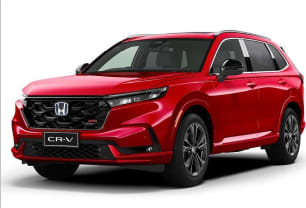Three things struck me the moment I stepped inside the C5.
Firstly, though the silhouette suggests a low-slung car, the tall stance means getting in and out isn’t a drama at all, with the seats being up high enough for this to deserve its SUV/crossover status.
Secondly, the Chery emits a somewhat repellent plastic off-gas odour, a bit like a cheap toy. The smell never goes away. Perhaps it was just our test car? Unlikely though, as it reminds me of pre-2000s Kias and Hyundais.
And in stark contrast, thirdly, there’s an arresting elegance to the dashboard’s minimalist layout and presentation. Nothing’s changed visually and nothing needed to.
Let’s concentrate on the many positive points first.
There’s plenty of space around you for a comparatively small and narrow SUV, including ample legroom and head room for your 178cm tester front and back. It doesn't feel cramped at all.
Finding the ideal driving position is easy, with most of the (available) switches and controls where you’d need them to be without having to stretch to reach. Helping things out here is an adjustable steering wheel for rake as well as reach. Unlike in an MG ZS.
The dash layout looks great, given that this car is of a 2022 vintage, with the large, twin 10.25-inch integrated displays for both the electronic instrumentation and the multimedia system seamlessly presented. Both are fairly clear and easy to work out and operate. And, despite being an older-generation vehicle (it’s now well into year four of production), the instruments still look fresh.
And though the C5 runs a software-based operating system for vehicle functions, climate, audio, multimedia and other settings, the few buttons provided are well integrated and mostly work logically.
Below the touchscreen is a row of haptic switches for the main heating and cooling elements, meaning just one touch is necessary and with no complicated and time-consuming sub-menus to navigate. That's good.
You do need to dive into sub-menus for some drive settings and modes, though, and that's disappointing, but at least the C5’s is not as complicated as some others we’ve experienced of late.
Other plus points include excellent ventilation and loads of storage, including a big old glovebox, a cavernous centre console bin, a vast lower area to hide things on, deep cupholders and a ‘wall’ to lean two phones or a tablet while still being visible for the driver to glance at, with one side providing wireless charging on the Ultimate grade.
Along with pleasant cloth seats that are surprisingly comfortable, all show a reassuring degree of thoughtfulness.
Additionally, the poor side and rear vision is at least aided by large side mirrors and a crisp reverse-camera views.
However, there are some serious downsides too, starting with the C5’s aforementioned phone/tablet wall. The rubber backing in our test car was misshapen and dog-eared, undermining the otherwise exemplary build quality.
Until you learn its weird ways, the gear shifter can be unfathomable. It looks like it would operate as per a regular T-bar, but pressing the side button to engage Drive or Reverse instead locks them out, meaning the uninitiated will inevitably find themselves panicking manoeuvring in traffic with impatient drivers wondering why a Chery is blocking the road during a cheeky three-point turn. Embarrassing and, yes, super frustrating.
In the Ultra at least, the lofty front passenger seat has no height adjustment. The digital radio did not work for the entire week we had the C5. Maybe it was just our car, but even in inner Melbourne, reception proved elusive.
And the touchscreen-based secondary climate settings that aren’t supported by physical buttons are a stretch away, including temperature adjustment, meaning these and other items are arranged for left-hand-drive access.
This means it is fiddly to operate, as concentration is not on the road ahead, resulting in the driver monitor sounding off, leading to more frustration. An unvirtuous circle of distraction ensues, highlighting the folly of software-based vehicle systems that have not been tailored to Australian road conditions. Fail.
But nothing is as aggravating as the Chery’s voice control system. Like we said earlier, when turned on, it mishears or misunderstands words to almost a comical degree… if it wasn’t so constantly intrusive. As with paranoid and/or trigger-happy ADAS warnings, you end up switching off such irritating tech. Which beggars the question: what is their point?
Moving to the back seat, things look up again, with sufficient space for most smaller families to settle into.
The bench is fine, offering adequate comfort for shorter journeys. Legroom is generous, helped out by room for boots to tuck underneath the front cushion. And most amenities are present for a base model car, including a folding armrest with two cupholders (again, unlike in an MG ZS), as well as one-touch electric windows, overhead grab handles, coat hooks, decent size door bins, a USB port and face level ventilation.
All those go towards making the C5 well-packaged, small family transport.
Further back, Chery has managed to liberate an extra 10 litres of cargo capacity compared to the old Omoda 5, so 360 litres is available – which is not bad for a small SUV. That rises to 1075L in two-seater mode.
It’s also a practical and easy boot to use, with a space saver spare wheel.






.png)













.png)





.png)


.png)

.png)

.png)



.png)

.png)
.png)

.png)


.png)




.png)








































.png)





.png)







.png)


















 copy.png)



















.png)























